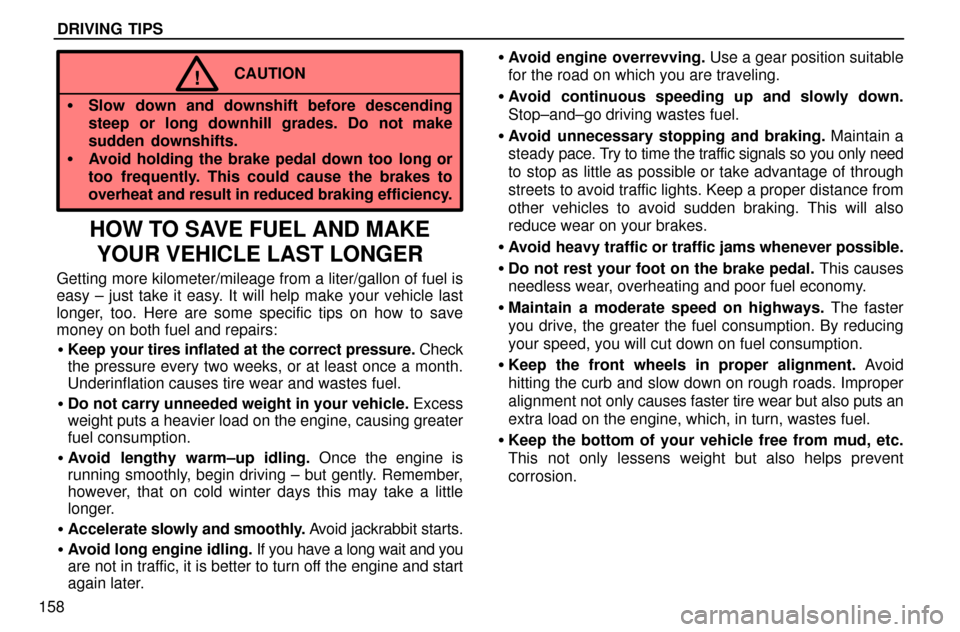Page 9 of 12

DRIVING TIPS
157
�Crosswinds and rough roads will adversely affect handling
of your vehicle and trailer, causing sway. Pay attention to
the rear from time to time to prepare yourself for being
passed by large trucks or buses, which may cause your
vehicle and trailer to sway. If swaying happens, firmly grip
the steering wheel and reduce speed immediately but
gradually. Never increase speed. If it is necessary to
reduce speed, brake slowly. Steer straight ahead. If you
make no extreme correction with the steering or brakes,
your vehicle and trailer will stabilize.
�Be careful when passing other vehicles. Passing requires
considerable distance. After passing a vehicle, do not
forget the length of your trailer and be sure you have plenty
of room before changing lanes.
�In order to maintain efficient engine braking and electrical
charging performance, do not use overdrive.
�Because of the added load of the trailer, your vehicle's
engine may overheat on hot days (at temperatures over
30�C [85�F]) when going up a long or steep grade with a
trailer. If the engine coolant temperature gauge indicates
overheating, immediately turn off the air conditioning (if in
use), pull your vehicle off the road and stop in a safe spot.
See ªIf your vehicle overheatsº on page 165 of this manual.
�Always place wheel blocks under both the vehicle and
trailer wheels when parking. Apply the parking brake firmly.
Put the transmission in ªPº (automatic) or in first or reverse
(manual). Avoid parking on a slope with a trailer, but if it
cannot be avoided, do so only after performing the
following:1. Apply the brakes and keep them applied.
2. Have someone place wheel blocks under both the
vehicle and trailer wheels.
3. When the wheel blocks are in place, release your brakes
slowly until the blocks absorb the load.
4. Apply the parking brake firmly.
5. Shift into ªPº and turn off the engine.
When restarting out after parking on a slope.
1. With the transmission in ªPº position, start the engine.
Be sure to keep the brake pedal depressed.
2. Shift into the ª2º, ªLº or ªRº position.
3. Release the parking brake pedal and slowly pull or back
away from the wheel blocks. Stop and apply your brakes.
4. Have someone retrieve the blocks.
CAUTION!
�Do not exceed 72 km/h (45 mph) or the posted
towing speed limit, whichever is lower. Because
instability (swaying) of a towing vehicle±trailer
combination usually increases as the speed
increases, exceeding 72 km/h (45 mph) may cause
loss of control.
Page 10 of 12

DRIVING TIPS
158
CAUTION!
�Slow down and downshift before descending
steep or long downhill grades. Do not make
sudden downshifts.
�Avoid holding the brake pedal down too long or
too frequently. This could cause the brakes to
overheat and result in reduced braking efficiency.
HOW TO SAVE FUEL AND MAKE
YOUR VEHICLE LAST LONGER
Getting more kilometer/mileage from a liter/gallon of fuel is
easy ± just take it easy. It will help make your vehicle last
longer, too. Here are some specific tips on how to save
money on both fuel and repairs:
�Keep your tires inflated at the correct pressure. Check
the pressure every two weeks, or at least once a month.
Underinflation causes tire wear and wastes fuel.
�Do not carry unneeded weight in your vehicle. Excess
weight puts a heavier load on the engine, causing greater
fuel consumption.
�Avoid lengthy warm±up idling. Once the engine is
running smoothly, begin driving ± but gently. Remember,
however, that on cold winter days this may take a little
longer.
�Accelerate slowly and smoothly. Avoid jackrabbit starts.
�Avoid long engine idling. If you have a long wait and you
are not in traffic, it is better to turn off the engine and start
again later.�Avoid engine overrevving. Use a gear position suitable
for the road on which you are traveling.
�Avoid continuous speeding up and slowly down.
Stop±and±go driving wastes fuel.
�Avoid unnecessary stopping and braking. Maintain a
steady pace. Try to time the traffic signals so you only need
to stop as little as possible or take advantage of through
streets to avoid traffic lights. Keep a proper distance from
other vehicles to avoid sudden braking. This will also
reduce wear on your brakes.
�Avoid heavy traffic or traffic jams whenever possible.
�Do not rest your foot on the brake pedal. This causes
needless wear, overheating and poor fuel economy.
�Maintain a moderate speed on highways. The faster
you drive, the greater the fuel consumption. By reducing
your speed, you will cut down on fuel consumption.
�Keep the front wheels in proper alignment. Avoid
hitting the curb and slow down on rough roads. Improper
alignment not only causes faster tire wear but also puts an
extra load on the engine, which, in turn, wastes fuel.
�Keep the bottom of your vehicle free from mud, etc.
This not only lessens weight but also helps prevent
corrosion.
Page 11 of 12
DRIVING TIPS
159 �Keep your vehicle tuned±up and in top shape. A dirty
air cleaner, improper valve clearance, dirty plugs, dirty oil
and grease, brakes not adjusted, etc. all lower engine
performance and contribute to poor fuel economy. For
longer life of all parts and lower operating costs, keep all
maintenance work on schedule, and if you often drive
under severe conditions, see that your vehicle receives
more frequent maintenance. (For scheduled maintenance
information, please refer to the separate ªOwner's Manual
Supplement/Maintenance Scheduleº.)
CAUTION!
Never turn off the engine to coast down hills. Your
power steering and brake booster will not function
without the engine running. Also, the emission
control system operates properly only when the
engine is running.
Page 12 of 12